Chinese Noodle Soup: The Ultimate Comfort Food Recipe (With Tips)
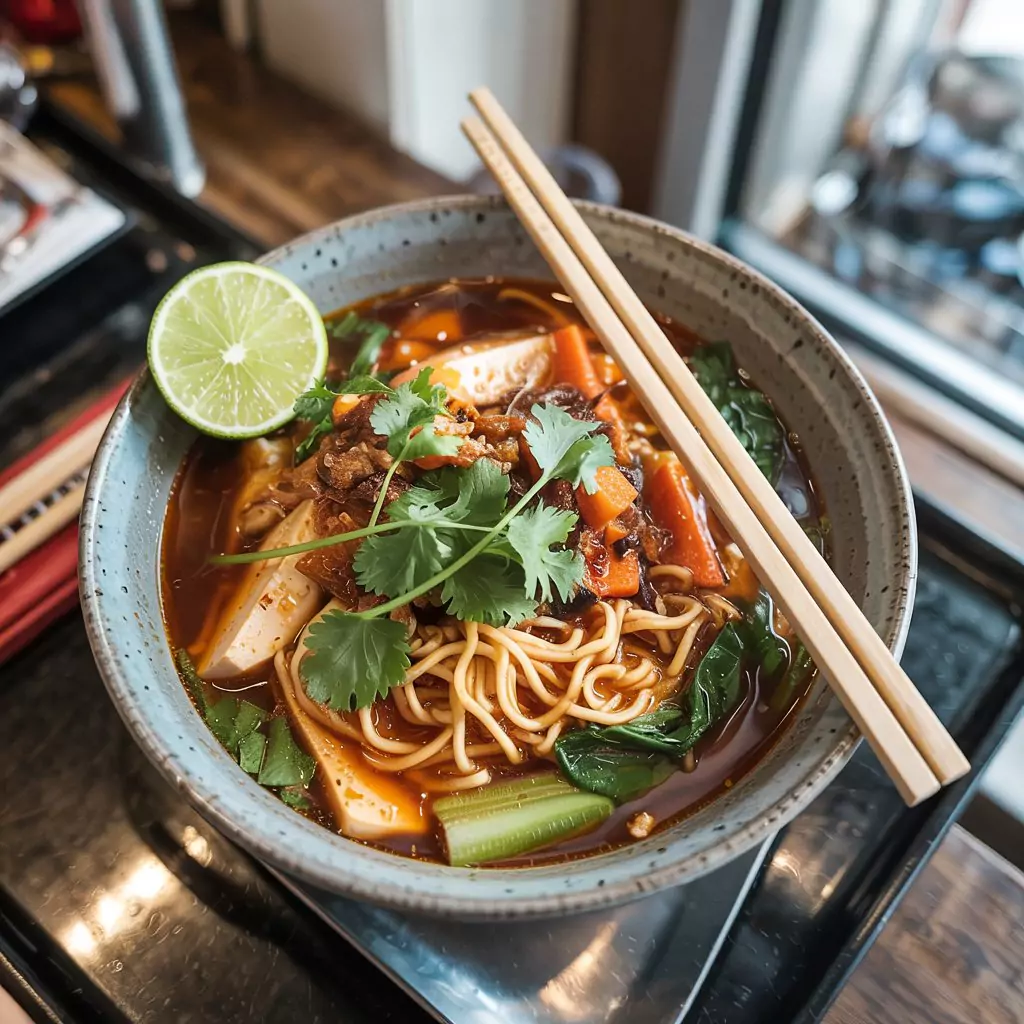
My Journey With This Hearty Bowl of Comfort
Let me tell you about my weird relationship with Chinese noodle soup. It started five years ago when I moved into my shoebox apartment in Chicago. The walls were so thin I could literally hear my neighbor Janet flossing her teeth every night at 10:43 PM. But the REAL problem? Every Sunday afternoon, she’d make this Chinese noodle soup that smelled so heavenly I found myself pressed against our shared wall, inhaling deeply like some sort of culinary creeper.
Three months of this pathetic behavior later (and after my friend at the time caught me with my nose literally touching the air vent), I finally broke down and knocked on her door. I brought a half-eaten pack of Oreos as a peace offering—classy, I know—and straight-up begged for her recipe.
Seven attempts, two smoke alarms, one small kitchen fire, and a chili oil explosion that made my white kitchen ceiling look like a crime scene from CSI: Kitchen Edition later… I finally cracked the code. Now this Chinese noodle soup is my signature dish. When friends ask what I’m bringing to potluck, they actually mean “You’re bringing that soup, right?” My mom has stopped sending me links to cooking classes. Progress!
Ingredients You’ll Need for Perfect Chinese Noodle Soup
For the broth (the part where all the magic happens in Chinese noodle soup):
- 8 cups chicken or vegetable stock (Look, the box from Trader Joe’s works fine. I made homemade stock ONCE and my apartment smelled like bones for three days)
- 3 cloves garlic, smashed (Just whack ’em with anything heavy. I’ve used a coffee mug when I couldn’t find my knife)
- 1-inch piece ginger, sliced (Pro tip: store yours in the freezer and grate it frozen—changed my life!)
- 2 star anise (those pretty star things that smell like licorice and make your Chinese noodle soup taste legit)
- 1 cinnamon stick (the ACTUAL stick, not the powder unless you want floaty bits in your broth)
- 2 tablespoons soy sauce (I use low-sodium because my doctor gave me The Look at my last checkup)
- 1 tablespoon sesame oil (the dark kind that costs way too much but lasts forever)
- 1/2 teaspoon white pepper (tastes nothing like black pepper and I will die on this hill)
For the noodles and toppings:
- 8 oz Chinese egg noodles (the yellow ones in the refrigerated section, but honestly? I’ve used spaghetti in desperate times and survived)
- 2 cups baby bok choy, quartered (the cutest little cabbages that make me feel sophisticated when I put them in my cart)
- 2 carrots, julienned (fancy chef-speak for “cut like matchsticks but don’t stress if they’re uneven”)
- 8 oz firm tofu, cubed (or chicken if tofu makes you sad)
- 3 green onions, thinly sliced (I grow these on my windowsill from the stumps of store-bought ones because it makes me feel like I have my life together)
- 1/4 cup cilantro, roughly chopped (sorry to the genetic mutants who think this tastes like soap—maybe try basil?)
- 1 lime, cut into wedges (the secret weapon that makes people go “ooooh what’s in this?”)
- Chili oil or sriracha (optional, for when you’re congested or want to feel something)
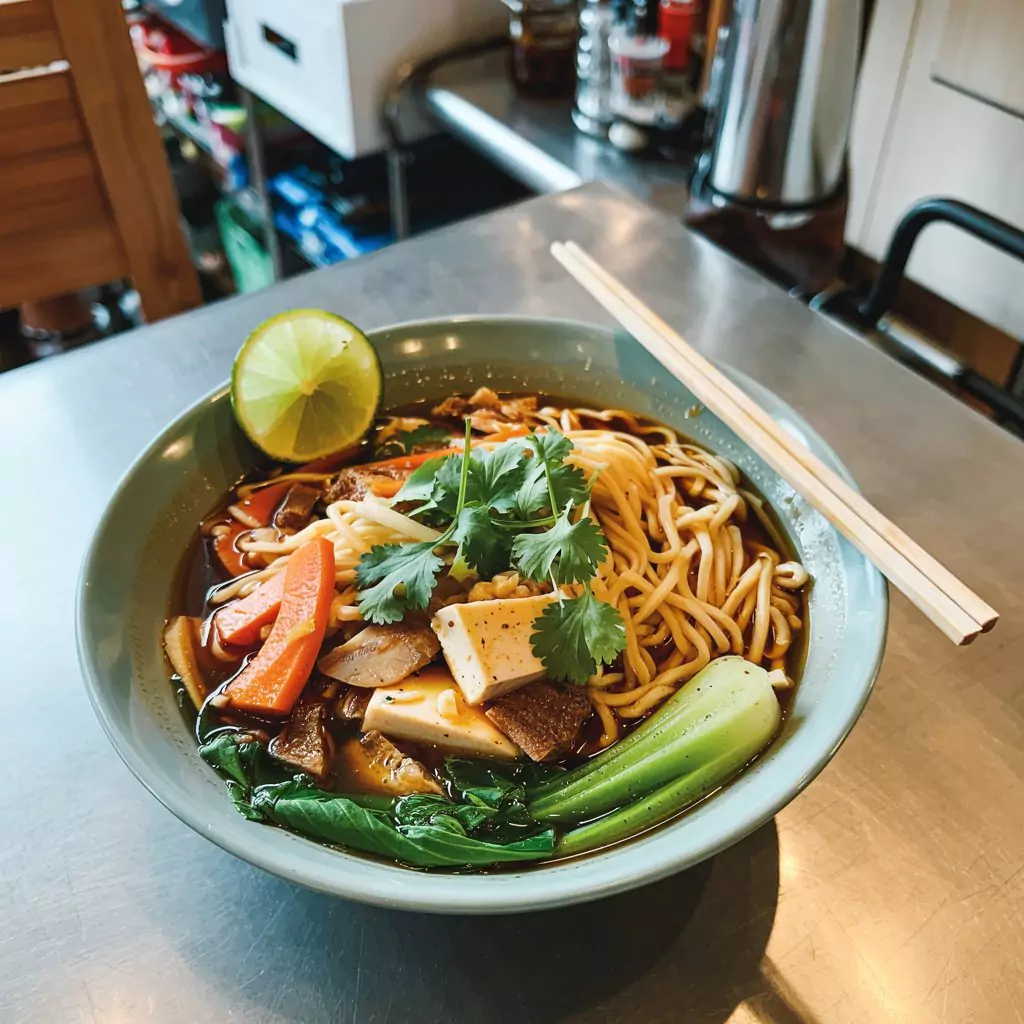
Timing: From Prep to Slurp
Preparation time: 15 minutes (roughly the length of my morning shower when I’m avoiding adult responsibilities) Cooking time: 25 minutes (or one episode of Succession minus the credits) Total time: 40 minutes (significantly less time than I spend scrolling TikTok every night telling myself “just 5 more minutes”)
The multitasking potential of Chinese noodle soup is what makes it my go-to when I need to appear competent. While the broth simmers, I’m chopping veggies, texting back that friend I’ve been ignoring for days, and occasionally swatting my cat Miso off the counter because he’s weirdly obsessed with stealing green onions.
Step-by-Step Instructions
Step 1: Create Your Aromatic Base
Grab that big pot you inherited from your grandma (or bought from IKEA during your “I’m going to start cooking real meals” phase). Splash in some oil—I say splash because who actually measures oil? Let it heat up until it does that shimmery thing. Toss in your smashed garlic and ginger. This is where the magic starts for your Chinese noodle soup.
Let them sizzle just until your kitchen smells amazing and your roommate/partner/nosy neighbor texts to ask what you’re making. Takes about a minute. WATCH CLOSELY because burnt garlic is the quickest way to end up ordering pizza instead. Not that I’m speaking from experience. (I am absolutely speaking from experience—RIP to the three batches of garlic bread I’ve cremated this year alone.)
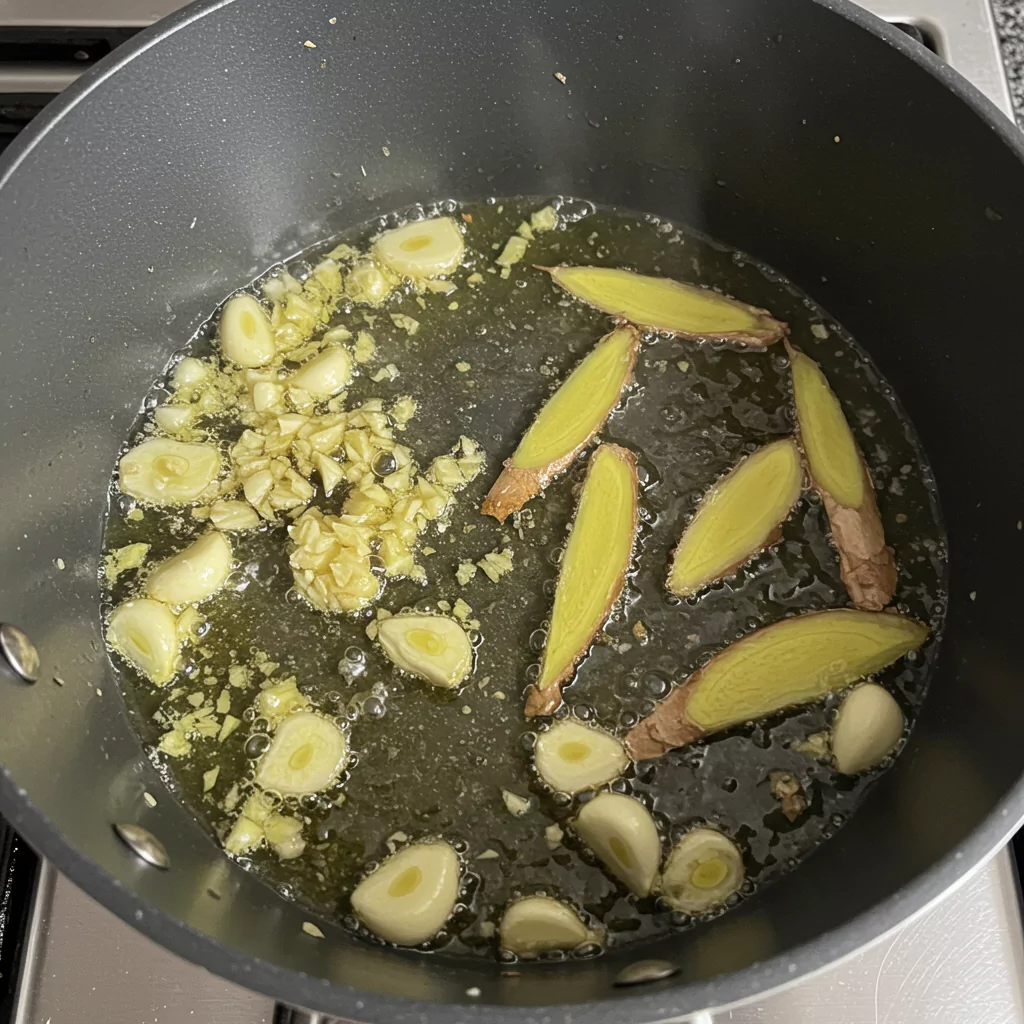
Step 2: Build Your Broth
Pour in your stock, making sure to splash a little on your stovetop, counter, and possibly your shirt (is it even cooking if you don’t need to change clothes afterward?). Chuck in the star anise, cinnamon stick, soy sauce, and white pepper.
Bring it to a boil, which is that moment when bubbles start forming and you panic because you were scrolling Instagram and almost let it boil over. Quickly turn it down to a simmer and set a timer for 15-20 minutes. My grandmother would give me The Look™ for this shortcut—she simmers her Chinese noodle soup broth for literally half a day, adding mysterious ingredients from unmarked jars. But honestly? This quick version is still delicious, and unlike my grandmother, I don’t have the patience of a saint or an entire day to watch soup.
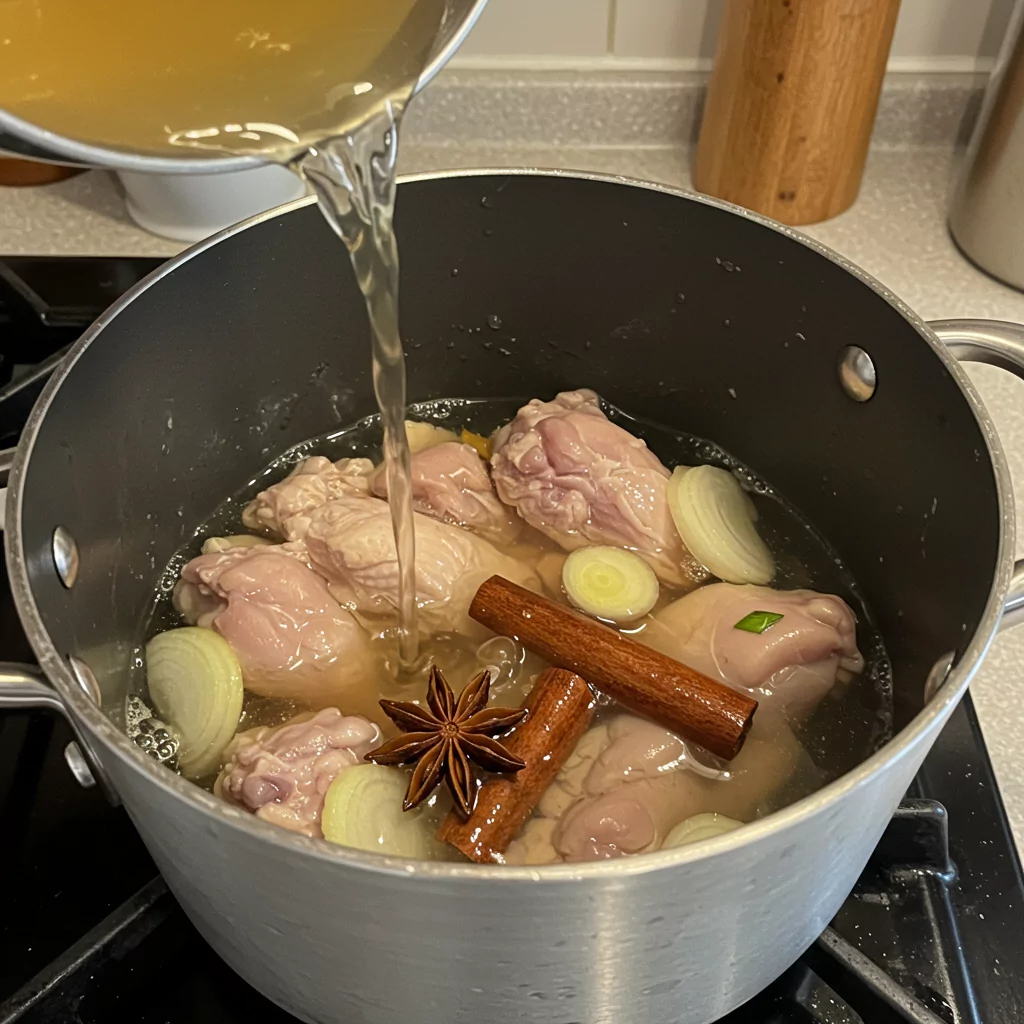
Step 3: Prepare Your Noodles
While your apartment transforms into what I imagine a Chinese herbalist’s shop smells like, cook your noodles in a separate pot. IMPORTANT LIFE LESSON: Always, ALWAYS take one minute off whatever cooking time the package suggests. I learned this the hard way after serving what can only be described as “noodle mush”.
After draining, rinse with cold water immediately. This stops them from cooking further and prevents them from forming one giant mega-noodle, which is cool in theory but terrible for your Chinese noodle soup experience.
Step 4: Prep Your Vegetables and Proteins
Quick-blanch that bok choy for like 30 seconds max. Any longer and they turn into those sad, military-green vegetables that haunted school cafeterias. Plunge them into ice water right after—it’s called “shocking” the vegetables, which sounds way more dramatic than it is. I like to make a little “sssss” sound effect when I do it because cooking should be fun and I live alone so no one can judge me.
If you’re using chicken instead of tofu, poach it directly in your broth for about 7-10 minutes. Then shred it using two forks while pretending you’re a velociraptor tearing into prey. What? Just me? Fine.
Step 5: Assemble Your Chinese Noodle Soup
Strain your broth to get all the floaty bits out. I use my mesh strainer that I bought specifically for this recipe after a regrettable incident involving star anise and my front tooth. Bring the broth back to a gentle simmer and toss in the carrots for 2 minutes.
Assembly time! This is where you can pretend you’re on a cooking show. Place noodles artfully in bowls (and then immediately mess them up trying to get them evenly distributed). Pour hot broth over everything with dramatic flair. Arrange toppings in what I call “organized chaos”—carefully placed for the Instagram photo I’ll take and then immediately stirred into oblivion before eating.
Finish with green onions and cilantro scattered with what appears to be careless abandon but actually took three attempts to look “effortlessly messy.”
Healthier Alternatives for the Recipe
Let’s be real—sometimes I’m wearing my fitness tracker and feeling virtuous, other times I’m eating spray cheese directly from the can at 2 AM. For those “I should probably eat a vegetable today” moments, here are some tweaks to make this Chinese noodle soup marginally healthier:
- Swap regular noodles for zucchini noodles (I bought a spiralizer after watching exactly one health influencer’s Instagram story, used it twice, and now it lives in The Drawer of Abandoned Kitchen Gadgets along with my avocado slicer and egg separator)
- Use coconut aminos instead of soy sauce (it’s allegedly healthier but mostly makes me feel superior when I put it in my Whole Foods cart)
- Add extra veggies like mushrooms, which basically disappear in the broth anyway so it’s like tricking yourself
- Use bone broth if you want to sound fancy at dinner parties (“Oh, this Chinese noodle soup? It’s made with BONE BROTH…” hair flip)
- Add turmeric because my aunt Karen won’t stop sending me Facebook articles about inflammation, and honestly, my knees DO hurt after my disastrous attempt to learn roller skating last summer
Serving Suggestions and Storing Tips for the Recipe
Turn dinner into a whole experience by creating a DIY Chinese noodle soup bar. It’s the perfect way to distract guests from the fact that soup is literally the only thing you know how to cook! Set out little bowls of:
- Bean sprouts (they add crunch and make you feel like you’re at a restaurant even though you’re eating on your couch)
- Thinly sliced jalapeños (to identify which of your friends can’t handle spice but pretend they can)
- Extra lime wedges (citrus makes everything taste better—it’s basically kitchen magic)
- Chopped peanuts (that I definitely didn’t steal from my last Pad Thai delivery)
- Soy sauce (for that friend who seasons food without tasting it first, KEVIN)
When I’m trying to convince my parents that the culinary arts degree I didn’t finish wasn’t a complete waste, I’ll make a quick cucumber salad on the side. Just slice cucumbers super thin (use a vegetable peeler if knife skills aren’t your thing), toss with rice vinegar, a pinch of sugar, and sesame seeds. Takes 3 minutes but makes people think you’ve got your culinary life together.


Storing Tips for the Recipe
The worst food crime I’ve ever committed was storing fully assembled Chinese noodle soup in one container. Don’t be like past-me. By day two, the noodles had absorbed ALL the broth and expanded to create what I can only describe as “soup-flavored noodle pudding.” Learn from my mistakes:
- Store broth separately in containers. I use old pasta sauce jars because I’m “eco-friendly” (read: too cheap to buy proper storage containers and too proud to ask for Tupperware for Christmas again)
- Keep noodles in their own container with a tiny splash of sesame oil mixed through. This prevents what I call “the noodle borg”—when they fuse into one giant mega-noodle that you have to awkwardly bite pieces off of
- Put prepped toppings in those plastic takeout sauce containers you’ve been hoarding (we all do it)
- When reheating, just warm the broth, then add everything else at the last minute. It’ll taste 95% as good as fresh, which is still better than most things I cook
I actually make double batches of just the broth and freeze it in an ice cube tray I stole from my college roommate 8 years ago (sorry, Becca). Once frozen, I transfer the broth cubes to a freezer bag labeled “NOT VODKA” after an unfortunate misunderstanding with my last houseguest.
Why This Chinese Noodle Soup Has Ruined Me For All Other Soups
There’s something almost therapeutic about hunching gargoyle-style over a steaming bowl of this soup, noodles dangling from chopsticks (or a fork if it’s been A Day), broth splattering on my shirt (which is why I own primarily dark-colored tops now). This Chinese noodle soup has gotten me through job rejections, three breakups, one pandemic, and that time my upstairs neighbor decided to learn tap dancing at midnight every day for a month.
I served this soup to my now-boyfriend on our third date, and he later confessed he knew I was “the one” because I didn’t judge him for the slurping noises he made while eating it. TRUE LOVE.
I’m DYING to hear if you make this! Did your kids actually eat vegetables without performing a full dramatic production? Did you also somehow get broth in your hair? (How does this happen? Every. Single. Time.) Did you impress someone special or just treat yourself to some self-care in a bowl? Drop a comment below or tag me on Instagram using #SoupTherItIs!
The best part about sharing this Chinese noodle soup recipe is seeing all the weird variations people come up with. Last month, I served it to Janet—yes, original wall-sharing Janet who started this whole obsession—and she asked for MY recipe! Full circle moment that made me feel like maybe, just maybe, I’m not completely hopeless in the kitchen after all. Now grab those chopsticks (or that fork, or that spoon, or that combination of utensils that works for you—we’re not soup snobs here) and get slurping!
Recipes You May Like
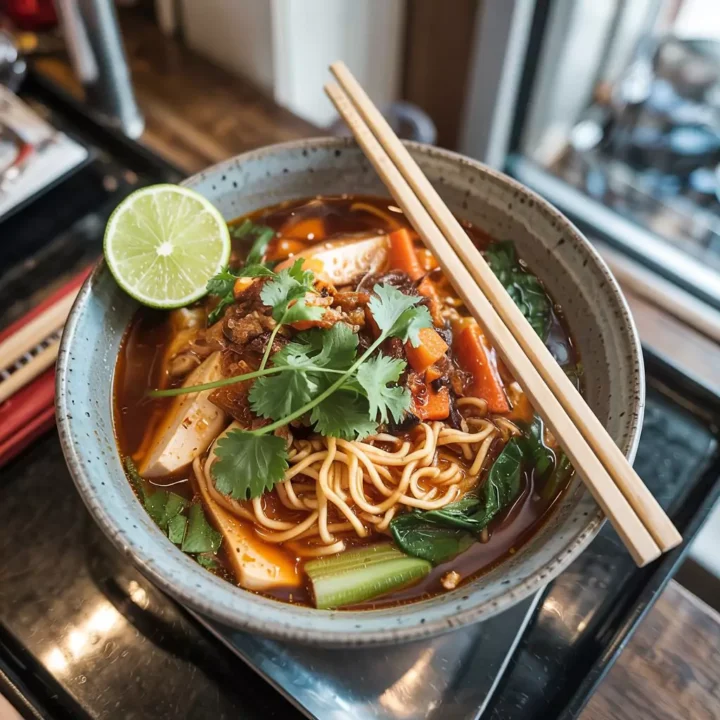
Chinese Noodle Soup
Make this easy, quick Chinese Noodle Soup! Aromatic, flavorful comfort food ready in 40 mins. Perfect homemade taste your family will love. Try it tonight!
Ingredients
- 8 cups chicken or vegetable stock (Look, the box from Trader Joe's works fine. I made homemade stock ONCE and my apartment smelled like bones for three days)
- 3 cloves garlic, smashed (Just whack 'em with anything heavy. I've used a coffee mug when I couldn't find my knife)
- 1-inch piece ginger, sliced (Pro tip: store yours in the freezer and grate it frozen—changed my life!)
- 2 star anise (those pretty star things that smell like licorice and make your Chinese noodle soup taste legit)
- 1 cinnamon stick (the ACTUAL stick, not the powder unless you want floaty bits in your broth)
- 2 tablespoons soy sauce (I use low-sodium because my doctor gave me The Look at my last checkup)
- 1 tablespoon sesame oil (the dark kind that costs way too much but lasts forever)
- 1/2 teaspoon white pepper (tastes nothing like black pepper and I will die on this hill)
- 8 oz Chinese egg noodles (the yellow ones in the refrigerated section, but honestly? I've used spaghetti in desperate times and survived)
- 2 cups baby bok choy, quartered (the cutest little cabbages that make me feel sophisticated when I put them in my cart)
- 2 carrots, julienned (fancy chef-speak for "cut like matchsticks but don't stress if they're uneven")
- 8 oz firm tofu, cubed (or chicken if tofu makes you sad)
- 3 green onions, thinly sliced (I grow these on my windowsill from the stumps of store-bought ones because it makes me feel like I have my life together)
- 1/4 cup cilantro, roughly chopped (sorry to the genetic mutants who think this tastes like soap—maybe try basil?)
- 1 lime, cut into wedges (the secret weapon that makes people go "ooooh what's in this?")
- Chili oil or sriracha (optional, for when you're congested or want to feel something)
Instructions
Step 1: Create Your Aromatic Base
Grab that big pot you inherited from your grandma (or bought from IKEA during your "I'm going to start cooking real meals" phase). Splash in some oil—I say splash because who actually measures oil? Let it heat up until it does that shimmery thing. Toss in your smashed garlic and ginger. This is where the magic starts for your Chinese noodle soup.
Let them sizzle just until your kitchen smells amazing and your roommate/partner/nosy neighbor texts to ask what you're making. Takes about a minute. WATCH CLOSELY because burnt garlic is the quickest way to end up ordering pizza instead. Not that I'm speaking from experience. (I am absolutely speaking from experience—RIP to the three batches of garlic bread I've cremated this year alone.)

Step 2: Build Your Broth
Pour in your stock, making sure to splash a little on your stovetop, counter, and possibly your shirt (is it even cooking if you don't need to change clothes afterward?). Chuck in the star anise, cinnamon stick, soy sauce, and white pepper.
Bring it to a boil, which is that moment when bubbles start forming and you panic because you were scrolling Instagram and almost let it boil over. Quickly turn it down to a simmer and set a timer for 15-20 minutes. My grandmother would give me The Look™ for this shortcut—she simmers her Chinese noodle soup broth for literally half a day, adding mysterious ingredients from unmarked jars. But honestly? This quick version is still delicious, and unlike my grandmother, I don't have the patience of a saint or an entire day to watch soup.

Step 3: Prepare Your Noodles
While your apartment transforms into what I imagine a Chinese herbalist's shop smells like, cook your noodles in a separate pot. IMPORTANT LIFE LESSON: Always, ALWAYS take one minute off whatever cooking time the package suggests. I learned this the hard way after serving what can only be described as "noodle mush".
After draining, rinse with cold water immediately. This stops them from cooking further and prevents them from forming one giant mega-noodle, which is cool in theory but terrible for your Chinese noodle soup experience.
Step 4: Prep Your Vegetables and Proteins
Quick-blanch that bok choy for like 30 seconds max. Any longer and they turn into those sad, military-green vegetables that haunted school cafeterias. Plunge them into ice water right after—it's called "shocking" the vegetables, which sounds way more dramatic than it is. I like to make a little "sssss" sound effect when I do it because cooking should be fun and I live alone so no one can judge me.
If you're using chicken instead of tofu, poach it directly in your broth for about 7-10 minutes. Then shred it using two forks while pretending you're a velociraptor tearing into prey. What? Just me? Fine.
Step 5: Assemble Your Chinese Noodle Soup
Strain your broth to get all the floaty bits out. I use my mesh strainer that I bought specifically for this recipe after a regrettable incident involving star anise and my front tooth. Bring the broth back to a gentle simmer and toss in the carrots for 2 minutes.
Assembly time! This is where you can pretend you're on a cooking show. Place noodles artfully in bowls (and then immediately mess them up trying to get them evenly distributed). Pour hot broth over everything with dramatic flair. Arrange toppings in what I call "organized chaos"—carefully placed for the Instagram photo I'll take and then immediately stirred into oblivion before eating.
Finish with green onions and cilantro scattered with what appears to be careless abandon but actually took three attempts to look "effortlessly messy."
Notes
Nutrition Information:
Yield: 4Amount Per Serving: Calories: Approximately 350 calories per serving
Tried This Recipe? Share Your Thoughts!
There are no reviews yet. Be the first one to write one.






